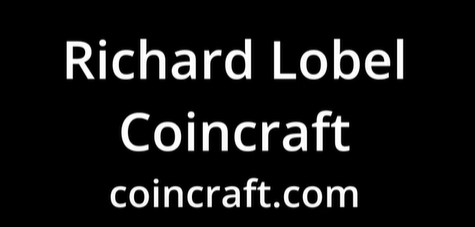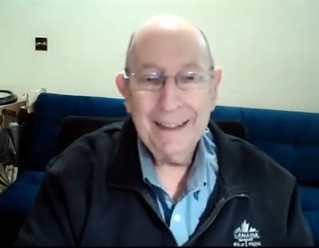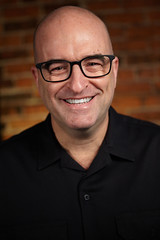
PREV ARTICLE
NEXT ARTICLE
FULL ISSUE
PREV FULL ISSUE
RICHARD LOBEL INTERVIEW PART FOURGreg Bennick's latest interview for the Newman Numismatic Portal is with London dealer Richard Lobel. Here's the fourth part, where Richard talks about the business Coincraft has become today. -Editor Greg Bennick: What is the scope of Coincraft today? I'm assuming that was sometime around, let's say that, or like you said, the early 70s or so. How did it grow? What did it become?
Greg Bennick: Incredible. So, you've got all the space and you've got an entire building across from the British Museum at this point. Richard Lobel: Yes. We have a -- well, there's a flat above. But, yes, we have the entire building, we own the building. And we're literally, we've got a giant Victorian penny that must be, I don't know, 5 foot across as a sign outside. You know, it's one of the few places in London where you come in and look and these things on display and everything's priced. Because I think there's nothing worse than going into a place and not seeing something priced. You know, if you don't price it, you're ashamed of it. This is the price we want. And as for discounts, we very rarely give discounts unless you're a good customer and you're spending some, you know. We basically tell people we're a fixed price shop. And that's what it is. And we've got all new -- well, not all new staff, but new people and they enjoy being there and they enjoy talking to the people and helping the people. And it's great. You know? I love it. Greg Bennick: This is wonderful. Now, given the scope of Coincraft, yet the personal nature of it, meaning it's obviously become immense and you're processing tons of orders, yet you're still personal in terms of your approach to your customers. You probably have a good sense of what people are collecting more or less. And my question is, what are people collecting in London? Because in the States, I can -- I've got a pretty good handle on what people are looking for at the major coin shows and that sort of thing. But in London, what are people collecting? Richard Lobel: Well, let's start off with the modern things from the Royal Mint. And the Royal Mint and I have a love-hate relationship. We both love to hate each other. Except that when the Queen died, they ran out of coins, and they had to buy them from me. I sold them 24,000 1953 Coronation Crowns because I thought over the years it was cheap, but I kept buying them. You have to understand when I say a large inventory, if you want 20,000 1977 crowns. That's no problem. If you want 10,000 Churchill crowns, if you want 1,440 Charles and Diana Crowns in Silver Proof, that's no problem. We have them. It's all paid for. I don't owe anybody any money, so I can do what I want. Greg Bennick: So, the inventory is massive. It's what you're saying basically. Richard Lobel: I would say yes. Yes. I would say it's -- I mean, with my wife's thing and the banknotes, we've handled a lot of hoards of banknotes. We owned and have been disbursing the hoard of Italy's first banknotes from 1746 to 1798. We bought them originally from Guido Crapanzano in Italy. I bought them actually in partnership with David Laties from Educational Coin Company. And six months later, he sold me his half. So, we're down to about a million dollars catalog left of them. As I say, I love buying. I don't mind quantity. When the £5 pound note changed from paper to polymer, I went and bought 5,000 pieces of the £5 pound note in paper and just put them aside. Because I think they're great. Nobody else has them. Greg Bennick: Well, I know who to go to if I ever need 5 or 10 or 20,000 of anything, in the future. Richard Lobel: Don't forget, I bought that hoard of British military notes - it was 17 million banknotes and it weighed 15,000 kilos. Did you ever see what -- that Harrison Ford film where he he's chasing the, I don't know, one of the things. And at the end, they throw it in the back of this huge warehouse. Greg Bennick: Raiders of the Lost Ark. Yes. Richard Lobel: Right. Okay. That's it. Sorry. They found 17 million banknotes in Berlin that were made for the British military, and I was head of the consortium that bought them at the time. That was one of the times we had the Guinness Book of World Records…it was the largest and heaviest and most expensive lot of banknotes ever sold at the time. Greg Bennick: Unbelievable. Unbelievable. Okay. So, a question for you. Going back a few minutes, to something you mentioned. Tell me about the difference as you see it between coin collecting as a hobby and coin buying as an investment. You said you don't sell coins for investment…. Richard Lobel: Not at all. If you came in with £50,000 pounds in cash and wanted to invest in coins, we'd say no. We would try and convert you to become a collector and how much more fun it can be. But, no, we don't sell anything of investment. We just don't do it. Greg Bennick: Now, and my question then is and I'm just curious. It makes perfect sense why you would want to take the approach that you do, and I appreciate it so much. But a business mind would say, well, you could make a profit on that person's £50,000 pounds and sell them an investment. Yet, why do you then choose from a business perspective not to do it? I mean, is it just out of love for the hobby? Richard Lobel: Because in the early 1970s I sold coins as investment. And everything went fine until the coin market went down and people wanted to sell, and I felt sorry for them. You know? I decided at that point, no, I wasn't going to do it. Greg Bennick: That makes perfect sense. That's really honorable. And also, it increases your fun. When you focus on the fun and the collector, the collector who comes in, rather than the investor. It just -- it means that you're in touch with more kindred spirits like yourself. Richard Lobel: I look at the American coins and I see the rare coins, and I see that 18 different people have owned it in the last 10 years. They're not collectors. They're bloody investors. I don't need the money. You know, I'm happy enough with the business we run. I know we could make a lot more money. But I'm happy enough doing what we're doing. That's -- I live very comfortably. I live in a mews house. You know what a mews house is? Greg Bennick: I don't actually. Tell me. Richard Lobel: Okay. In the old days, you had the big houses. And in the back, you had a stable. Where the horses stayed and the grooms lived on top, on the first floor. That's called a mews, M-E-W-S. And I live in a mews which is actually great because it's a cul de sac. And my next door neighbor is the Swiss embassy. Literally, I have a wall with the Swiss embassy. And, of course, they've carted them up tremendously, and it looks really much better, and they're very expensive now because everything in London is bloody expensive. But yeah. You know, I'm happy doing that. I live comfortably. I have a nice house, got 3 bedrooms, 3 bathrooms, got a garage. I don't have a car but I've a garage. I've got everything I want.
To watch the complete video, see:
To read the complete transcript, see:
To read the earlier E-Sylum articles, see:
THE BOOK BAZARREWayne Homren, Editor The Numismatic Bibliomania Society is a non-profit organization promoting numismatic literature. See our web site at coinbooks.org. To submit items for publication in The E-Sylum, write to the Editor at this address: whomren@gmail.com To subscribe go to: https://my.binhost.com/lists/listinfo/esylum All Rights Reserved. NBS Home Page Contact the NBS webmaster 
|


